The Land
History of the Site
Mike, a founding member of Puyallup Cohousing, bought the farm in 1988 from two elderly sisters who had been growing raspberries on the land since sometime around World War II. In the past, the Puyallup valley was a prime location for raspberry production, with all of the attendant infrastructure necessary to support farming berries. Local raspberry farms diminished in number as their lands were converted to housing and other development. The local packing company closed up shop. Large farms further north were more suitable for automation, hence making hand picking of small farms less competitive. Today, raspberries are a distant memory with other crops such as beans, corn, and pumpkins filling the void.
Development of the Puyallup Valley has continued, and sadly, farmlands are becoming less and less feasible. How best to serve as a good steward for as much as possible of the land in perpetuity? A caring cohousing community seems like a reasonable answer.
The farm consists of three contiguous tax parcels of land totaling 17 acres in Pierce County, WA. Two of the parcels (10.75 acres) are within the City of Puyallup’s future urban growth boundary, zoned for residential both in Pierce County and in the City of Puyallup’s long term zoning plans. Our plan is to develop as a group of clustered homes, thereby preserving as much of the land as possible while still satisfying the critical identified needs for more middle housing in the area.
Photos of Land

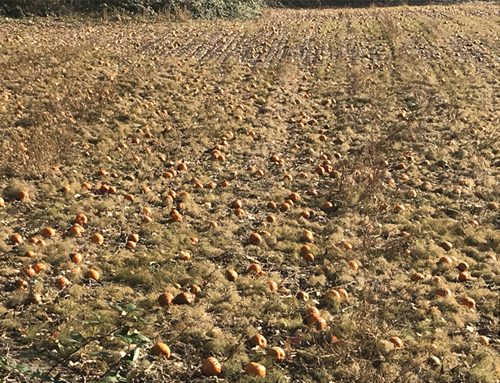


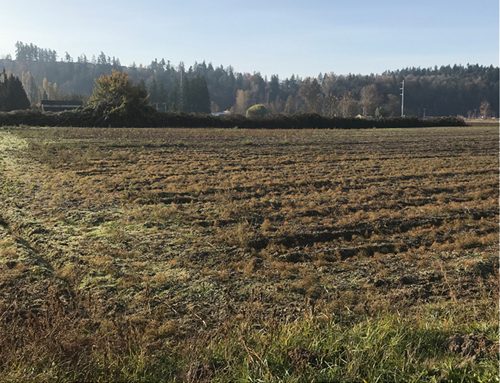







Overhead Site View

Unit Development Concepts
We are targeting an ‘ideal’ community size measured as 40-50 adults, instead of the usual measurement of 25-35 units. We are choosing to use bedrooms as a proxy for adults, and settled on a 48 bedroom community. Our initial thinking about unit plans followed the tried and true cohousing approach of maximizing the number of units as zoning would allow. Our zoning allows 4 units/acre and the 1st parcel we are planning to develop is 4 acres. So our first concept was 16 3bed/2bath units, with one of the bedrooms configured to act as a tiny home with ~300 sq ft of space that includes a bath and a kitchenette. Below are the sketches of our first plan courtesy of Bryan Bowman of Caddis.
1500 sq ft 3/2 Unit Floorplan Concept
Our initial building block was a ~1500 sq ft, 1 story, 3 bedroom/2 bath unit designed for easy sharing and co-living. Each bedroom would have access to the core as well as individual entrances to the outside. One of the bedrooms would be oversized (~300 sq ft) to function as a studio or ‘tiny home’ with its own bath and kitchenette.
This layout was designed to be easy for either conventionally stick-built construction onsite, or 14’x44′ modular units built in a factory and trucked to the site.
The intent was to allow for easy sharing as desired. Some scenarios: a large family in the whole space; a smaller family in the 2/1 with an unrelated occupant in the ‘tiny’; or three unrelated individuals. The amenities in the common house would serve as a valuable extension of the living quarters.
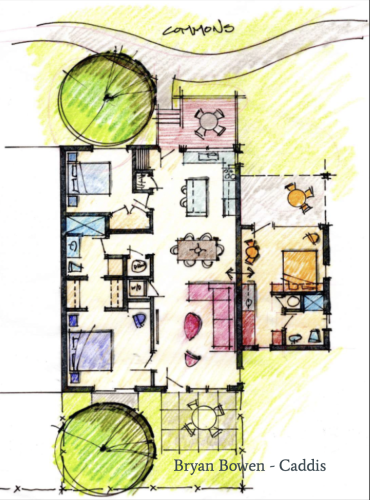
Flipped for a 3000 sq ft 6/4 Duplex

Duplex design is a compromise that preserves more land and open space at the expense of a shared wall.
Looked at through the lens of design for sharing/co-living begs the question: Could we reduce costs by designing this to be a 3000 sq ft ‘McMansion’ with our 6 bedrooms and 4 baths instead of a duplex? Some duplicated space could be eliminated and many construction costs are assigned as a function of ‘units’ and not ‘people’…
Evolution of Unit Concepts
In September of 2024, just as we were prepared to proceed by asking our civil engineer to prepare the design package for a permit application for a 16 units arranged as 8 duplexes on the 4 acre parcel, we became aware the Pierce County was undergoing a 10-year update to it’s comprehensive plan due on Dec 31st, 2024. For an anxious few months it looked like our zoning would be cut in half in the new comp plan, only allowing 2 units per acre! (In late December, days before the plan was to be submitted, the county approved our amendment which restored our original 4 unit/acre zoning. YAY!)
The unexpected zoning challenge encouraged us to consider alternate schemes for housing 48 bedrooms which involved more and more sharing in the units. Below are concepts we developed showing sixteen 3 bedroom units, twelve 4 bedroom units, and eight 6 bedroom units. Note that the percentage of ‘tiny home’ bedrooms grows as the unit count shrinks. An unexpected side benefit was the realization that fewer units engenders fewer costly unit-based county fees…
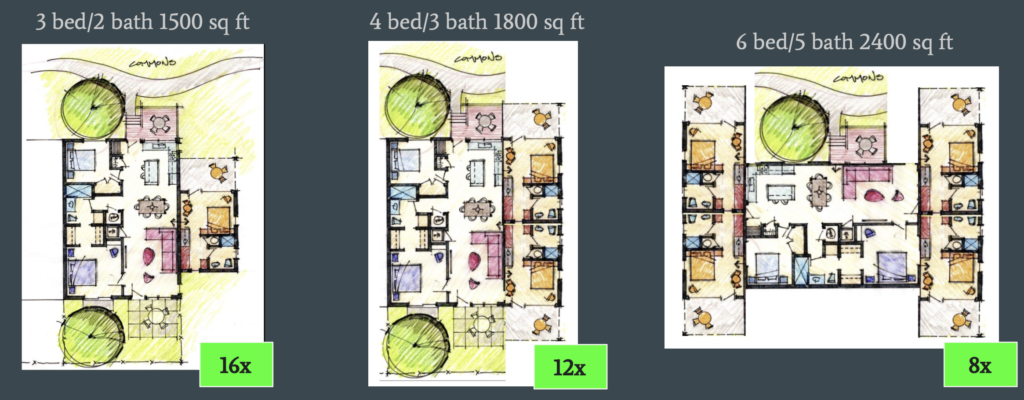
The 6 bedroom/5 bath concept is attractive to us

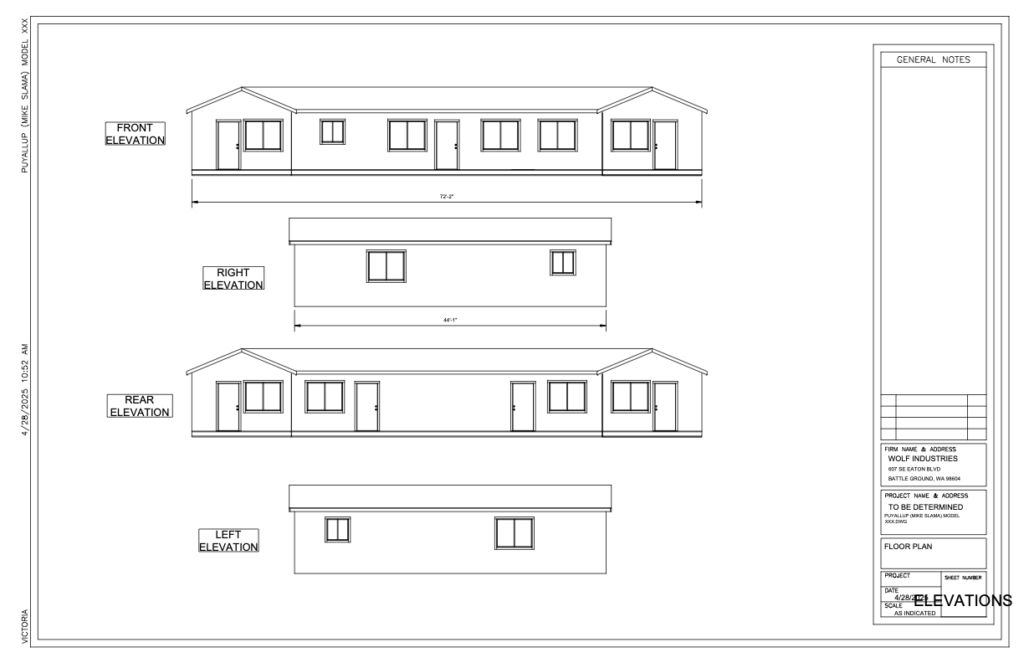
This model significantly lowers the cost of entry, particularly for individuals who start with a ‘tiny home’ bedroom while still benefiting from the full range of community resources. Unlike standalone backyard ADUs, which often isolate occupants, our model integrates private spaces within a larger, interconnected community. Every resident has access to shared amenities, including the common house, gardens, workshops, and other collective spaces, fostering a more social and supportive environment.
A single, highly standardized floor plan simplifies construction and maintenance while offering flexible living arrangements. Depending on their needs, we anticipate that residents could purchase or rent living spaces of 300, 600, 1200, 1500, 1800, 2100, or 2400 square feet. With modular construction, each home arrives in four pre-built sections, ready for rapid assembly. This efficiency allows homes to be built and installed within weeks rather than months, reducing construction costs and minimizing disruption to the community.
The flexible design naturally accommodates residents as they transition through different life stages—from singles to couples, to families, and back again. By integrating adaptable financial and legal structures, we aim to make it easy for residents to scale their living space up or down as their needs evolve. This ensures long-term stability, affordability, and the ability to remain within the community throughout different phases of life.
Preliminary Site Layout Sketch
This work-in-progress layout shows the eight 6-bedroom units on the 4 acre parcel which will support our ideal community size of 40-50 people – especially if our preferred concept of co-living is successful.
Parking is split with both uncovered parking (2 per unit) and garage (1 per unit) or storage units as well.
This concept anticipates a phased approach to construction in order to take advantage of a cycle of learning. We need to submit plans for the whole development to the county and are considering options on the Phase 2 6.75 acre parcel.
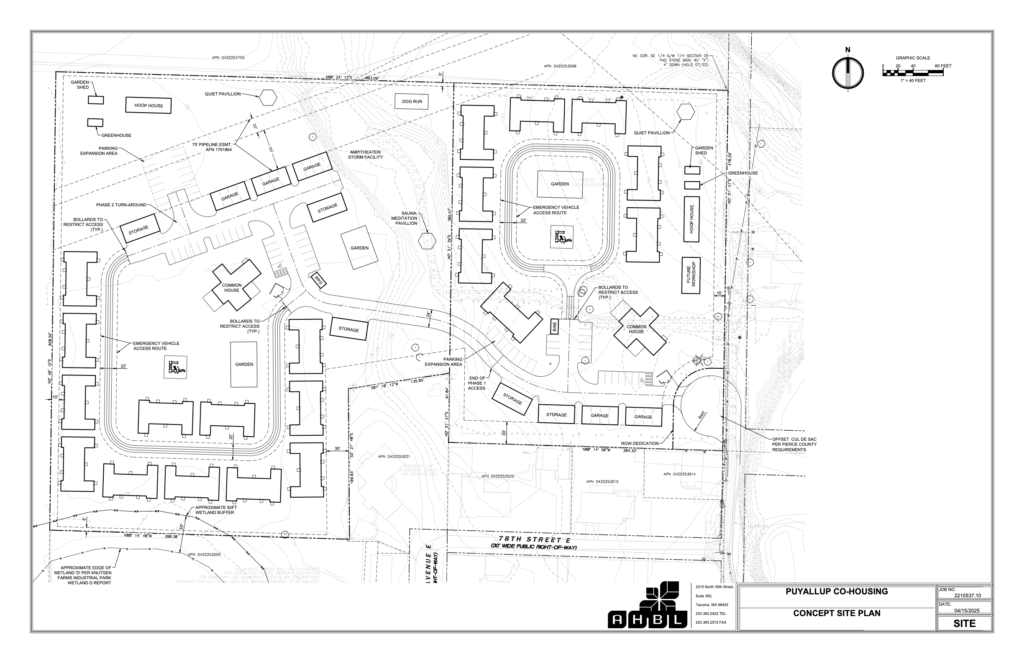
Preliminary Common House Sketch and Elevations
We need to supply our common house plans as part of our preliminary land use submittal to the county.
The diagram to the right includes a floor plan layout and elevations.
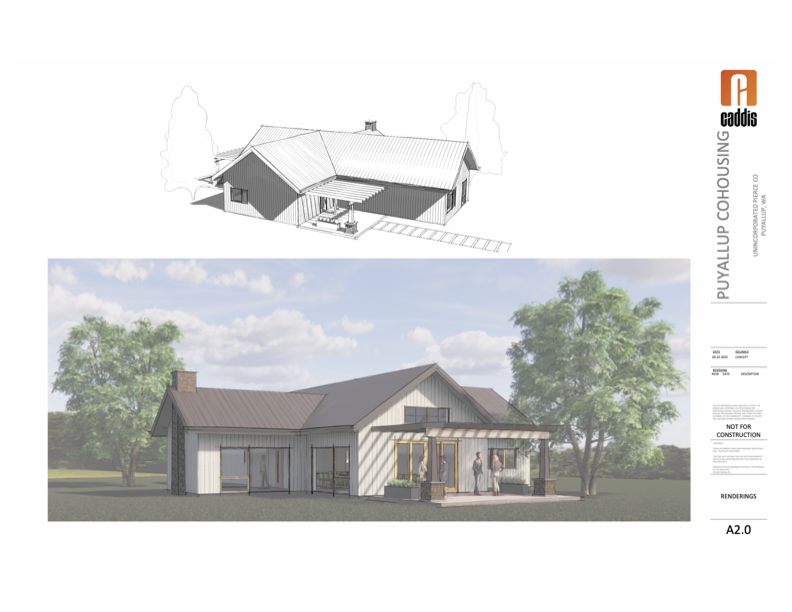
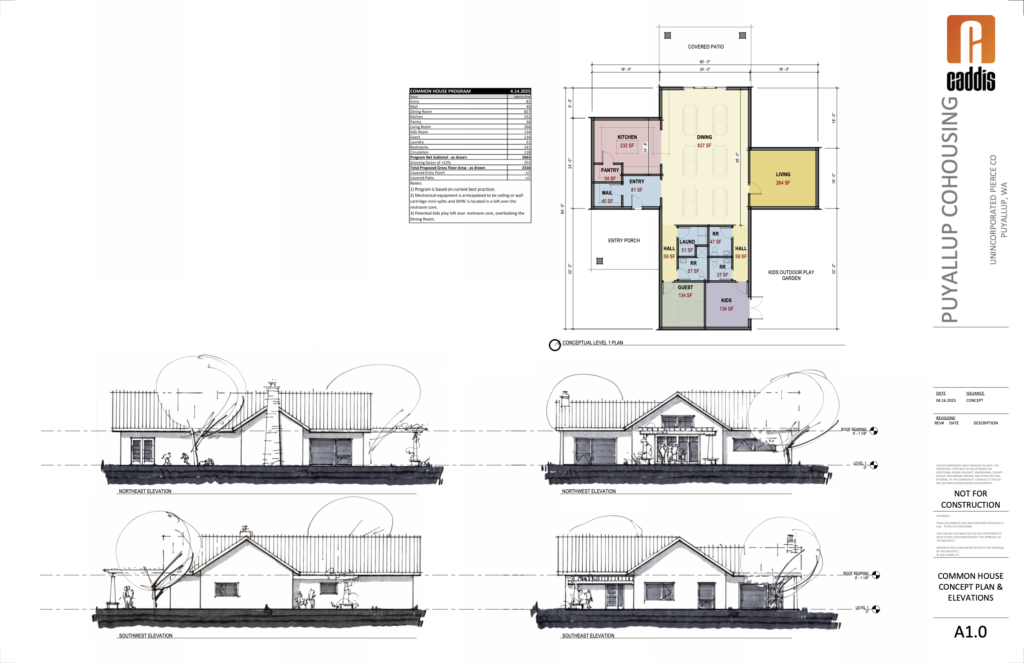
Current Development Narrative (April 2025)
Philosophy
Puyallup Cohousing envisions a dynamic, sustainable community designed for shared living, affordability, and flexibility. Our goal is to provide an innovative housing model that balances private space with strong community connections, offering an alternative to traditional single family homeownership. We are abandoning the standard definition of ideal community size as measured by ’25-35 units’ in favor of measuring ideal size as ’40-50 people’ (with bedrooms used as a proxy).
We are abandoning the standard ‘community led’ approach in favor of ‘developer led’. This implies that our development strategy will be ‘backwards’ compared to the usual cohousing schema. The developer will finance and make all of the key decisions regarding land, site layout, unit layout, legal structure and costs first. The group formation will be last with members only opting into the development if they like the choices made. We will need to develop an explicit method of socialization rather than relying on socialization happening during the endless meetings typical of community-led development. We accept the fact that the risk to the developer is HUGE in going so far off the beaten path with an untested concept.
Phased development – two communities
Our Phase 1 community will accommodate approximately 48 people across eight single-story, six-bedroom homes on a 4 acre parcel. Each residence will be approximately 2,400 square feet, contributing to a total of approximately 19,200 square feet of living space among the 8 units. Our intent will be to try and have at least one person per bedroom, with 32 of the 48 bedrooms designed as “tiny homes” with kitchenette and private bath. All bedrooms will be designed with two doors: One door will access the house core and another door serving as a private access to the commons. Designed to promote co-ownership, co-living, or shared rental opportunities, these homes will create a versatile and flexible living environment. It will be essential for the occupants of each unit to decide on the ground rules regarding access and use of the shared space.
The Phase 2 community site plan is a placeholder of sorts. Pierce County requires that the plan for the entire site be submitted at the beginning, regardless of phasing. Our site plan will show 12 single-story, 6 bedroom homes on the 6.75 acre parcel using the same unit floor plan as Phase 1 and will include a second common house and additional amenities. Our intent is to use the initial community on the 4 acre parcel as a ‘cycle of learning’ that will help us improve on the 6.75 acre parcel.
Modular Home Construction
To maximize efficiency and reduce construction costs, each home is composed of four factory manufactured modules, optimizing efficiency and cost. The dimensions of each module are 14′ x 44’, or approximately 600 sq ft. These include:
- Module 1: Shared kitchen, dining, and living space
- Module 2: Two bedrooms with an ADA-compliant bathroom
- Modules 3 & 4: Duplex bedroom units, each featuring a bedroom, bath, and kitchenette—functioning as independent studio apartments or ‘tiny home’ bedrooms
This standardized approach simplifies the building process while maintaining high-quality construction. The modular units are built to exceed International Residential Code (IRC) and International Building Code (IBC) standards, ensuring durability and long-term performance. With a single floor plan repeated across all homes, this design approach enhances consistency and cost-effectiveness without sacrificing comfort or functionality.
Common House and Shared Spaces
The cohousing community will eventually build a common house of approximately 2,000 – 3,000 square feet with shared amenities tailored to the needs of residents. We anticipate two common houses, one for the Phase 1 community and one for the Phase 2 community. To reduce initial costs, the Phase 1 community will start by repurposing an existing 1,500-square-foot home and 600-square-foot detached garage on an adjacent property to serve as an interim common house. As the community grows, residents will build a permanent common house, the location of which will be included in the site plan from the outset.
Incremental unit placement
Our site development strategy will allow modular homes to be placed one at a time as demand grows, reducing upfront capital costs and financial risk. By separating ‘horizontal’ site work from ‘vertical’ unit construction, we hope to avoid the financial burden of building all eight homes at once as is typical in ‘stick-built’ construction. Each modular home can be built off-site and transported to a pre-prepared foundation, allowing for efficient installation. With a factory build cycle of approximately 20 days per unit this approach mitigates the risks and delays associated with traditional 1-2 year stick-built construction timelines.
Accessibility and Inclusive Design
Accessibility is fundamental to our design philosophy. Every core two-bedroom layout meets Universal Design standards, incorporating features such as: 36-inch-wide doors for easy access, Roll-in no-lip showers, Roll-under sinks and other universal design recommendations. These elements ensure that residents can age in place comfortably, fostering a long-term, inclusive living environment. As the saying goes: “If we’re lucky, we’ll all live long enough to be disabled.”
Legal and Financial Structure
To promote affordability and financial sustainability, we are exploring alternative ownership models such as a limited-equity cooperative, a condominium where each unit in turn is a condominium, or a condominium where unit is an LLC. The goal is to balance flexibility, collective decision-making, and long-term affordability while minimizing speculative pressure on housing costs. Our chosen legal framework will ensure that residents have financial accessibility and security while fostering a strong sense of community. We may or may not accept outside investors depending on the legal structure that we choose.
Schedule and Costs:
We are planning on submitting a preliminary land use application to Pierce County by no later than mid May, 2025. Rumor has it that Pierce County can easily take up to 12 months to issue permits! Since this is the first cohousing project for the County it will likely require a bit of back-and-forth negotiations as we proceed.
Costs will be determined over the next few months. We’ll be soliciting bids for the various facets of the development over the summer.
Conclusion
By integrating thoughtful design, shared resources, and innovative ownership models, Puyallup Cohousing will offer a truly inclusive, adaptable, and financially accessible living environment. Our vision is to foster a vibrant, interdependent community where individuals can thrive—today and in the future.

